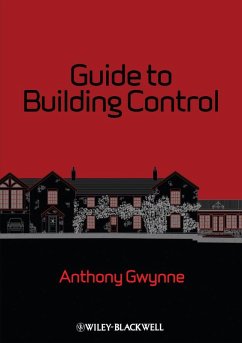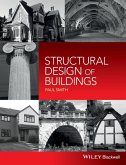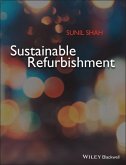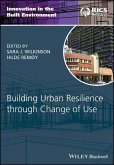- Broschiertes Buch
- Merkliste
- Auf die Merkliste
- Bewerten Bewerten
- Teilen
- Produkt teilen
- Produkterinnerung
- Produkterinnerung
To clarify the practical requirements of the Building Regs and help you meet their requirements first go, all the information contained in the building regulations 2010 and approved documents is presented here in an easy-to-understand format, clear, concise and fully illustrated.
Guidance is given for domestic buildings of up to three storeys in England and Wales, including extensions, loft conversions, new dwellings, conversions (garages, basements and barns), and upgrading of existing buildings - including the use of natural lime mortars, plasters renders and paints. There are clear…mehr
Andere Kunden interessierten sich auch für
![Structural Design of Buildings Structural Design of Buildings]() Paul SmithStructural Design of Buildings70,99 €
Paul SmithStructural Design of Buildings70,99 €![Sustainable Refurbishment Sustainable Refurbishment]() Sunil ShahSustainable Refurbishment83,99 €
Sunil ShahSustainable Refurbishment83,99 €![Building Performance Analysis Building Performance Analysis]() Pieter de WildeBuilding Performance Analysis132,99 €
Pieter de WildeBuilding Performance Analysis132,99 €![Building Urban Resilience Through Change of Use Building Urban Resilience Through Change of Use]() Building Urban Resilience Through Change of Use150,99 €
Building Urban Resilience Through Change of Use150,99 €![Sustainable Surface Water Management Sustainable Surface Water Management]() Sustainable Surface Water Management135,99 €
Sustainable Surface Water Management135,99 €![Retrofitting Cities for Tomorrow's World Retrofitting Cities for Tomorrow's World]() Retrofitting Cities for Tomorrow's World160,99 €
Retrofitting Cities for Tomorrow's World160,99 €![The Smart Estate The Smart Estate]() Jason ChallenderThe Smart Estate73,99 €
Jason ChallenderThe Smart Estate73,99 €-
-
-
To clarify the practical requirements of the Building Regs and help you meet their requirements first go, all the information contained in the building regulations 2010 and approved documents is presented here in an easy-to-understand format, clear, concise and fully illustrated.
Guidance is given for domestic buildings of up to three storeys in England and Wales, including extensions, loft conversions, new dwellings, conversions (garages, basements and barns), and upgrading of existing buildings - including the use of natural lime mortars, plasters renders and paints. There are clear explanations of how the technical design and construction requirements of the Building Regs can be met with sufficient information to draw up an effective specification and design to be developed.
Guide to Building Control illustrates the design and construction of the various building elements and explains the principles and processes of the building regulations and approved documents - including structure, fire safety, contaminates, sound insulation, ventilation, water efficiency, drainage systems, combustion appliances, stairs and guarding, energy conservation/green building issues, disabled access, safety glazing, electrical safety, materials and workmanship.
The Guide contains up-to-date examples of everyday practices and procedures gained by the author - a practicing building control surveyor - from years of responding to requests from property professionals, builders, property owners and students for clarification of the practical requirements of the building regulations.
Accompanied by detailed diagrams, tables and text offering an enlightened understanding of the complexities of building regulations the Guide is both an authoritative reference for use at planning stage and a practical handbook on site. Students and professionals will find it an essential, easy-to-use resource for building control surveyors, building designers, building contractors, self-build, and others working in the construction industry.
Guidance is given for domestic buildings of up to three storeys in England and Wales, including extensions, loft conversions, new dwellings, conversions (garages, basements and barns), and upgrading of existing buildings - including the use of natural lime mortars, plasters renders and paints. There are clear explanations of how the technical design and construction requirements of the Building Regs can be met with sufficient information to draw up an effective specification and design to be developed.
Guide to Building Control illustrates the design and construction of the various building elements and explains the principles and processes of the building regulations and approved documents - including structure, fire safety, contaminates, sound insulation, ventilation, water efficiency, drainage systems, combustion appliances, stairs and guarding, energy conservation/green building issues, disabled access, safety glazing, electrical safety, materials and workmanship.
The Guide contains up-to-date examples of everyday practices and procedures gained by the author - a practicing building control surveyor - from years of responding to requests from property professionals, builders, property owners and students for clarification of the practical requirements of the building regulations.
Accompanied by detailed diagrams, tables and text offering an enlightened understanding of the complexities of building regulations the Guide is both an authoritative reference for use at planning stage and a practical handbook on site. Students and professionals will find it an essential, easy-to-use resource for building control surveyors, building designers, building contractors, self-build, and others working in the construction industry.
Produktdetails
- Produktdetails
- Verlag: Wiley & Sons
- 1. Auflage
- Seitenzahl: 336
- Erscheinungstermin: 6. Mai 2013
- Englisch
- Abmessung: 246mm x 188mm x 18mm
- Gewicht: 703g
- ISBN-13: 9780470657539
- ISBN-10: 0470657537
- Artikelnr.: 36391935
- Herstellerkennzeichnung
- Libri GmbH
- Europaallee 1
- 36244 Bad Hersfeld
- gpsr@libri.de
- Verlag: Wiley & Sons
- 1. Auflage
- Seitenzahl: 336
- Erscheinungstermin: 6. Mai 2013
- Englisch
- Abmessung: 246mm x 188mm x 18mm
- Gewicht: 703g
- ISBN-13: 9780470657539
- ISBN-10: 0470657537
- Artikelnr.: 36391935
- Herstellerkennzeichnung
- Libri GmbH
- Europaallee 1
- 36244 Bad Hersfeld
- gpsr@libri.de
Anthony Gwynne, MRICS, MIFireE, is a Chartered Surveyor and Fire Engineer and has 35 years' experience in the construction industry. He co-manages a building control section and has been in building control for over 19 years. He has been responsible for overseeing the building control function of major developments, including commercial, industrial, healthcare, residential, housing developments, bespoke dwellings, extensions, conversions and works to heritage buildings. From 1976 to 1977 he worked in Canada on construction projects and from 1977 to 1986 he was apprenticed as a banker mason and was responsible for conservation projects with CADW (Welsh historic monuments and buildings). Following further academic study, he was later with English Heritage as a professional and technical officer, responsible for historic monuments in the south of England. From 1986 to 1993 he was a Building Surveyor with a local authority, dealing with the repair and planned maintenance of buildings including contract procurement and contract administration.
About the Author xi
Acknowledgements xiii
Notes to the Reader xv
Expected Changes to the Building Regulations to Come into Force in 2013
xvii
Section 1 General information 1.1
Introduction 1.3
The Building Act 1984 and the Building Regulations 2010 1.3
Approved Documents 1.4
Other ways of satisfying the Building Regulations requirements 1.5
Technical and condensation risks 1.5
Timber-sizing tables independently calculated by GEOMEX for solid timber
members 1.6
Engaging a property professional 1.6
Obtaining Building Regulations approval 1.7
Notices of stages of works 1.9
Exempt buildings and work 1.9
Preliminary works 1.11
Matters related to the Building Regulations 1.14
The Party Wall Act 1996 1.15
Rights of Light 1.17
Section 2 Domestic extensions 2.1
Part A: Structure 2.9
A1: Sub-structure 2.9
Foundations 2.9
Ground floors and sub-structure walls 2.18
A2: Superstructure 2.28
Minimum headroom heights 2.28
External walls 2.28
External cavity wall construction 2.35
Lateral restraint strapping of upper floors to walls 2.49
Lateral restraint strapping of roofs to walls 2.51
Lateral restraint strapping of walls at ceiling level 2.52
A3: Separating walls and floors 2.53
Masonry party walls separating dwellings 2.53
Double-leaf timber-frame party walls separating dwellings 2.54
A4: Internal partitions 2.56
A5: Intermediate upper floor(s) 2.56
Floor joists 2.56
Trimming and trimmer joists 2.58
A6: Pitched roofs 2.60
Pitched roof coverings 2.61
Pitched roof structure 2.62
A7: Flat-roof construction 2.70
Option 1: Flat roof with 'cold deck' 2.70
Option 2: Flat roof with 'warm deck' 2.72
Option 3: Flat roof with inverted 'warm deck' (insulation on top of
waterproof coverings) 2.74
Option 4: Flat roof with green roof on 'warm deck' (either intensive or
extensive) 2.74
The design, workmanship and selection of materials for flat roofs 2.75
A8: Mortars, renders and gypsum plasters 2.75
Cement mortars and renders 2.75
Gypsum plasters 2.77
Part B: Fire safety and means of escape 2.78
Fire detection and fi re alarm systems 2.78
Means of escape 2.79
Surface spread of flame: internal wall and ceiling linings including roof
lights 2.89
Part C: Site preparation and resistance to contaminants and moisture 2.92
C1: Resistance to contaminants 2.92
Radon gas 2.93
Methane and other ground gas protection 2.96
C2: Resistance to moisture 2.96
Part D: Cavity wall filling with insulation 2.98
Part E: Resistance to the passage of sound 2.98
Part F: Ventilation 2.99
Purge (natural) ventilation 2.99
Mechanical extract ventilation and fresh air inlets for rooms without purge
ventilation 2.99
Background ventilation 2.100
Intermittent mechanical extract ventilation 2.100
Part G: Sanitation, hot-water safety and water efficiency 2.100
Wholesome hot and cold water supply 2.100
Solar water heating 2.102
Electrical water heating 2.102
Insulation of pipework to prevent freezing 2.102
Supply (Water Fittings) Regulations 1999 2.103
Part H: Drainage and waste disposal 2.103
H1: Foul- and storm-water drainage 2.103
H2: Septic tanks, sewage treatment systems and cesspools 2.113
Septic tanks 2.113
Sewage treatment systems 2.114
Percolation tests 2.116
Cesspools 2.118
H3: Rainwater drainage and harvesting 2.119
H4: Building over or close to, and connections to, public sewers 2.122
Building over or close to a public sewer 2.122
Connections to public sewers 2.123
H5: Separate systems of drainage 2.124
H6: Solid waste storage 2.124
Part J: Combustion appliances and fuel storage systems 2.124
Solid fuel appliances up to 50 kW rated output 2.125
Appliances other than solid fuel 2.133
Fuel storage tanks 2.134
Renewable energy/micro regeneration installations 2.134
Part K: Protection from falling, collision and impact 2.135
Internal stairs, guarding and landings for changes in level of 600 mm or
more 2.135
External stairs, guarding and landings for changes in level of 600 mm or
more 2.138
Loft conversion stairs 2.139
Ramps 2.140
Part L: Conservation of fuel and power in existing dwellings 2.141
Areas of external windows, roof windows and doors 2.141
New thermal elements 2.141
Energy-efficient lighting 2.143
Insulation of pipework to prevent freezing 2.143
External walls, roofs, floors and swimming-pool basin 2.143
Renovation/upgrading of existing thermal elements 2.144
Part M: Access to and use of buildings for disabled 2.145
Part N: Safety glazing, opening and cleaning 2.146
Safety glass and glazing 2.146
Part P: Electrical safety 2.147
Electrical installations 2.147
External works - paths, private drives, patios and gardens 2.149
Section 3 New dwellings 3.1
Parts A and L: Starting point 3.4
Conservation of fuel and power in new dwellings 3.4
Criterion 1 - Achieving the Target Emission Rate (TER) 3.4
Criterion 2 - Limits on design flexibility 3.5
Criterion 3 - Limiting the effects of solar heat gain 3.5
Criterion 4 - Calculation of the Dwelling Design Emission Rate (DER) 3.6
Criterion 5 - Provision for energy-efficient operation of the dwelling 3.10
Insulation guidance details for floors, walls and roofs 3.10
Guidance on the Code for Sustainable Homes for new dwellings 3.12
Guidance on PassivHaus 3.18
Part B: Fire safety and means of escape 3.19
Part C: Site preparation and resistance to contaminants and moisture 3.20
Part D: Cavity wall filling with insulation 3.20
Part E: Resistance to the passage of sound 3.20
Part F: Ventilation to new dwellings 3.21
Ventilation systems 3.21
Purge (natural) ventilation to habitable rooms: system 1 - new dwellings
3.22
Background ventilation: system 1 - new dwellings 3.23
Intermittent mechanical extract ventilation: system 1 - new dwellings 3.24
Part G: Sanitation, hot-water safety and water efficiency 3.24
Part H: Drainage and waste disposal 3.25
Part J: Combustion appliances and fuel storage systems 3.26
Part K: Protection from falling, collision and impact 3.26
Part L: Conservation of fuel and power 3.26
Part M: Access to and use of buildings for disabled 3.26
Guidance on Lifetime Homes Standard for new dwellings 3.31
Part N: Safety glazing, opening and cleaning 3.32
Part P: Electrical safety 3.32
Section 4 Domestic loft conversions 4.1
Converting an existing loft space 4.3
Assessing the feasibility of your loft for conversion 4.3
Part A: Structure 4.5
A1: Inspection of the existing roof and building structure 4.5
A2: Alteration, modification and strengthening of the existing roof
structure 4.5
A3: Roof conversion details 4.5
Upgrading existing external walls 4.5
Internal load-bearing timber stud walls 4.7
Part B: Fire safety and means of escape 4.11
Single-storey dwellings with loft conversion 4.11
Two-storey dwellings with loft conversion (or new third storey) 4.13
Part C: Site preparation and resistance to contaminants and moisture 4.17
Part D: Cavity wall fi lling with insulation 4.17
Part E: Resistance to the passage of sound 4.17
Part F: Ventilation 4.17
Part G: Sanitation, hot-water safety and water efficiency 4.17
Part H: Drainage and waste disposal 4.17
Part J: Combustion appliances and fuel storage systems 4.17
Part K: Protection from falling, collision and impact 4.17
Part L: Conservation of fuel and power in conversions 4.17
Part M: Access to and use of buildings for disabled 4.18
Part N: Safety glazing, opening and cleaning 4.18
Part P: Electrical safety 4.18
Section 5 Domestic garage and basement conversions into habitable rooms and
conversion of barns and similar buildings into new dwellings 5.1
Assessing the feasibility of your building for conversion 5.6
Part A: Structure 5.14
A1: Underpinning works 5.14
Traditional underpinning 5.14
Sections through proposed underpinning (not to scale) 5.15
A2: Single-wall garage conversions (or similar buildings) into habitable
rooms (typical details indicated in Figures 5.2-5.12) 5.16
Upgrading pitched roofs 5.16
Upgrading flat roofs 5.19
Infilling of garage door openings 5.20
Upgrading single-skin external walls 5.21
Upgrading garage ground floors (or similar) with upgraded enclosing
single-skin walls 5.26
A3: Cavity wall garage conversions (or similar buildings) into habitable
rooms (typical details indicated in Figures 5.16-5.26) 5.29
Upgrading pitched roof 5.29
Infilling of garage door opening 5.31
Upgrading external cavity walls 5.33
Upgrading garage ground floors (or similar) with enclosing upgraded cavity
walls 5.34
A4: Basement conversions into habitable rooms 5.38
Existing basements and tanking systems 5.38
A5: Conversion of barns and similar buildings into new dwellings -
Technical and practical guidance 5.40
Part A: Structure 5.40
Part B: Fire safety and means of escape 5.51
Part C: Site preparation and resistance to contaminants and moisture 5.51
Part D: Cavity wall filling with insulation 5.51
Part E: Resistance to the passage of sound 5.51
Performance standards 5.51
Part F: Ventilation to new dwellings 5.52
Part G: Sanitation, hot-water safety and water efficiency 5.52
Part H: Drainage and waste disposal 5.53
Part J: Combustion appliances and fuel storage systems 5.53
Part K: Protection from falling, collision and impact 5.53
Part L: Conservation of fuel and power in conversions 5.53
Energy Performance Certificate (EPC) 5.53
Part M: Access to and use of buildings for disabled 5.53
Part N: Safety glazing, opening and cleaning 5.54
Part P: Electrical safety 5.54
Section 6 Upgrading old buildings using lime and modern applications 6.1
Upgrading old buildings using lime and modern applications 6.3
Re-pointing and repair of existing buildings 6.4
Types of lime mortar, lime render/plaster and decorative finish suitable
for breathable buildings 6.10
Index I.1
Acknowledgements xiii
Notes to the Reader xv
Expected Changes to the Building Regulations to Come into Force in 2013
xvii
Section 1 General information 1.1
Introduction 1.3
The Building Act 1984 and the Building Regulations 2010 1.3
Approved Documents 1.4
Other ways of satisfying the Building Regulations requirements 1.5
Technical and condensation risks 1.5
Timber-sizing tables independently calculated by GEOMEX for solid timber
members 1.6
Engaging a property professional 1.6
Obtaining Building Regulations approval 1.7
Notices of stages of works 1.9
Exempt buildings and work 1.9
Preliminary works 1.11
Matters related to the Building Regulations 1.14
The Party Wall Act 1996 1.15
Rights of Light 1.17
Section 2 Domestic extensions 2.1
Part A: Structure 2.9
A1: Sub-structure 2.9
Foundations 2.9
Ground floors and sub-structure walls 2.18
A2: Superstructure 2.28
Minimum headroom heights 2.28
External walls 2.28
External cavity wall construction 2.35
Lateral restraint strapping of upper floors to walls 2.49
Lateral restraint strapping of roofs to walls 2.51
Lateral restraint strapping of walls at ceiling level 2.52
A3: Separating walls and floors 2.53
Masonry party walls separating dwellings 2.53
Double-leaf timber-frame party walls separating dwellings 2.54
A4: Internal partitions 2.56
A5: Intermediate upper floor(s) 2.56
Floor joists 2.56
Trimming and trimmer joists 2.58
A6: Pitched roofs 2.60
Pitched roof coverings 2.61
Pitched roof structure 2.62
A7: Flat-roof construction 2.70
Option 1: Flat roof with 'cold deck' 2.70
Option 2: Flat roof with 'warm deck' 2.72
Option 3: Flat roof with inverted 'warm deck' (insulation on top of
waterproof coverings) 2.74
Option 4: Flat roof with green roof on 'warm deck' (either intensive or
extensive) 2.74
The design, workmanship and selection of materials for flat roofs 2.75
A8: Mortars, renders and gypsum plasters 2.75
Cement mortars and renders 2.75
Gypsum plasters 2.77
Part B: Fire safety and means of escape 2.78
Fire detection and fi re alarm systems 2.78
Means of escape 2.79
Surface spread of flame: internal wall and ceiling linings including roof
lights 2.89
Part C: Site preparation and resistance to contaminants and moisture 2.92
C1: Resistance to contaminants 2.92
Radon gas 2.93
Methane and other ground gas protection 2.96
C2: Resistance to moisture 2.96
Part D: Cavity wall filling with insulation 2.98
Part E: Resistance to the passage of sound 2.98
Part F: Ventilation 2.99
Purge (natural) ventilation 2.99
Mechanical extract ventilation and fresh air inlets for rooms without purge
ventilation 2.99
Background ventilation 2.100
Intermittent mechanical extract ventilation 2.100
Part G: Sanitation, hot-water safety and water efficiency 2.100
Wholesome hot and cold water supply 2.100
Solar water heating 2.102
Electrical water heating 2.102
Insulation of pipework to prevent freezing 2.102
Supply (Water Fittings) Regulations 1999 2.103
Part H: Drainage and waste disposal 2.103
H1: Foul- and storm-water drainage 2.103
H2: Septic tanks, sewage treatment systems and cesspools 2.113
Septic tanks 2.113
Sewage treatment systems 2.114
Percolation tests 2.116
Cesspools 2.118
H3: Rainwater drainage and harvesting 2.119
H4: Building over or close to, and connections to, public sewers 2.122
Building over or close to a public sewer 2.122
Connections to public sewers 2.123
H5: Separate systems of drainage 2.124
H6: Solid waste storage 2.124
Part J: Combustion appliances and fuel storage systems 2.124
Solid fuel appliances up to 50 kW rated output 2.125
Appliances other than solid fuel 2.133
Fuel storage tanks 2.134
Renewable energy/micro regeneration installations 2.134
Part K: Protection from falling, collision and impact 2.135
Internal stairs, guarding and landings for changes in level of 600 mm or
more 2.135
External stairs, guarding and landings for changes in level of 600 mm or
more 2.138
Loft conversion stairs 2.139
Ramps 2.140
Part L: Conservation of fuel and power in existing dwellings 2.141
Areas of external windows, roof windows and doors 2.141
New thermal elements 2.141
Energy-efficient lighting 2.143
Insulation of pipework to prevent freezing 2.143
External walls, roofs, floors and swimming-pool basin 2.143
Renovation/upgrading of existing thermal elements 2.144
Part M: Access to and use of buildings for disabled 2.145
Part N: Safety glazing, opening and cleaning 2.146
Safety glass and glazing 2.146
Part P: Electrical safety 2.147
Electrical installations 2.147
External works - paths, private drives, patios and gardens 2.149
Section 3 New dwellings 3.1
Parts A and L: Starting point 3.4
Conservation of fuel and power in new dwellings 3.4
Criterion 1 - Achieving the Target Emission Rate (TER) 3.4
Criterion 2 - Limits on design flexibility 3.5
Criterion 3 - Limiting the effects of solar heat gain 3.5
Criterion 4 - Calculation of the Dwelling Design Emission Rate (DER) 3.6
Criterion 5 - Provision for energy-efficient operation of the dwelling 3.10
Insulation guidance details for floors, walls and roofs 3.10
Guidance on the Code for Sustainable Homes for new dwellings 3.12
Guidance on PassivHaus 3.18
Part B: Fire safety and means of escape 3.19
Part C: Site preparation and resistance to contaminants and moisture 3.20
Part D: Cavity wall filling with insulation 3.20
Part E: Resistance to the passage of sound 3.20
Part F: Ventilation to new dwellings 3.21
Ventilation systems 3.21
Purge (natural) ventilation to habitable rooms: system 1 - new dwellings
3.22
Background ventilation: system 1 - new dwellings 3.23
Intermittent mechanical extract ventilation: system 1 - new dwellings 3.24
Part G: Sanitation, hot-water safety and water efficiency 3.24
Part H: Drainage and waste disposal 3.25
Part J: Combustion appliances and fuel storage systems 3.26
Part K: Protection from falling, collision and impact 3.26
Part L: Conservation of fuel and power 3.26
Part M: Access to and use of buildings for disabled 3.26
Guidance on Lifetime Homes Standard for new dwellings 3.31
Part N: Safety glazing, opening and cleaning 3.32
Part P: Electrical safety 3.32
Section 4 Domestic loft conversions 4.1
Converting an existing loft space 4.3
Assessing the feasibility of your loft for conversion 4.3
Part A: Structure 4.5
A1: Inspection of the existing roof and building structure 4.5
A2: Alteration, modification and strengthening of the existing roof
structure 4.5
A3: Roof conversion details 4.5
Upgrading existing external walls 4.5
Internal load-bearing timber stud walls 4.7
Part B: Fire safety and means of escape 4.11
Single-storey dwellings with loft conversion 4.11
Two-storey dwellings with loft conversion (or new third storey) 4.13
Part C: Site preparation and resistance to contaminants and moisture 4.17
Part D: Cavity wall fi lling with insulation 4.17
Part E: Resistance to the passage of sound 4.17
Part F: Ventilation 4.17
Part G: Sanitation, hot-water safety and water efficiency 4.17
Part H: Drainage and waste disposal 4.17
Part J: Combustion appliances and fuel storage systems 4.17
Part K: Protection from falling, collision and impact 4.17
Part L: Conservation of fuel and power in conversions 4.17
Part M: Access to and use of buildings for disabled 4.18
Part N: Safety glazing, opening and cleaning 4.18
Part P: Electrical safety 4.18
Section 5 Domestic garage and basement conversions into habitable rooms and
conversion of barns and similar buildings into new dwellings 5.1
Assessing the feasibility of your building for conversion 5.6
Part A: Structure 5.14
A1: Underpinning works 5.14
Traditional underpinning 5.14
Sections through proposed underpinning (not to scale) 5.15
A2: Single-wall garage conversions (or similar buildings) into habitable
rooms (typical details indicated in Figures 5.2-5.12) 5.16
Upgrading pitched roofs 5.16
Upgrading flat roofs 5.19
Infilling of garage door openings 5.20
Upgrading single-skin external walls 5.21
Upgrading garage ground floors (or similar) with upgraded enclosing
single-skin walls 5.26
A3: Cavity wall garage conversions (or similar buildings) into habitable
rooms (typical details indicated in Figures 5.16-5.26) 5.29
Upgrading pitched roof 5.29
Infilling of garage door opening 5.31
Upgrading external cavity walls 5.33
Upgrading garage ground floors (or similar) with enclosing upgraded cavity
walls 5.34
A4: Basement conversions into habitable rooms 5.38
Existing basements and tanking systems 5.38
A5: Conversion of barns and similar buildings into new dwellings -
Technical and practical guidance 5.40
Part A: Structure 5.40
Part B: Fire safety and means of escape 5.51
Part C: Site preparation and resistance to contaminants and moisture 5.51
Part D: Cavity wall filling with insulation 5.51
Part E: Resistance to the passage of sound 5.51
Performance standards 5.51
Part F: Ventilation to new dwellings 5.52
Part G: Sanitation, hot-water safety and water efficiency 5.52
Part H: Drainage and waste disposal 5.53
Part J: Combustion appliances and fuel storage systems 5.53
Part K: Protection from falling, collision and impact 5.53
Part L: Conservation of fuel and power in conversions 5.53
Energy Performance Certificate (EPC) 5.53
Part M: Access to and use of buildings for disabled 5.53
Part N: Safety glazing, opening and cleaning 5.54
Part P: Electrical safety 5.54
Section 6 Upgrading old buildings using lime and modern applications 6.1
Upgrading old buildings using lime and modern applications 6.3
Re-pointing and repair of existing buildings 6.4
Types of lime mortar, lime render/plaster and decorative finish suitable
for breathable buildings 6.10
Index I.1
About the Author xi
Acknowledgements xiii
Notes to the Reader xv
Expected Changes to the Building Regulations to Come into Force in 2013
xvii
Section 1 General information 1.1
Introduction 1.3
The Building Act 1984 and the Building Regulations 2010 1.3
Approved Documents 1.4
Other ways of satisfying the Building Regulations requirements 1.5
Technical and condensation risks 1.5
Timber-sizing tables independently calculated by GEOMEX for solid timber
members 1.6
Engaging a property professional 1.6
Obtaining Building Regulations approval 1.7
Notices of stages of works 1.9
Exempt buildings and work 1.9
Preliminary works 1.11
Matters related to the Building Regulations 1.14
The Party Wall Act 1996 1.15
Rights of Light 1.17
Section 2 Domestic extensions 2.1
Part A: Structure 2.9
A1: Sub-structure 2.9
Foundations 2.9
Ground floors and sub-structure walls 2.18
A2: Superstructure 2.28
Minimum headroom heights 2.28
External walls 2.28
External cavity wall construction 2.35
Lateral restraint strapping of upper floors to walls 2.49
Lateral restraint strapping of roofs to walls 2.51
Lateral restraint strapping of walls at ceiling level 2.52
A3: Separating walls and floors 2.53
Masonry party walls separating dwellings 2.53
Double-leaf timber-frame party walls separating dwellings 2.54
A4: Internal partitions 2.56
A5: Intermediate upper floor(s) 2.56
Floor joists 2.56
Trimming and trimmer joists 2.58
A6: Pitched roofs 2.60
Pitched roof coverings 2.61
Pitched roof structure 2.62
A7: Flat-roof construction 2.70
Option 1: Flat roof with 'cold deck' 2.70
Option 2: Flat roof with 'warm deck' 2.72
Option 3: Flat roof with inverted 'warm deck' (insulation on top of
waterproof coverings) 2.74
Option 4: Flat roof with green roof on 'warm deck' (either intensive or
extensive) 2.74
The design, workmanship and selection of materials for flat roofs 2.75
A8: Mortars, renders and gypsum plasters 2.75
Cement mortars and renders 2.75
Gypsum plasters 2.77
Part B: Fire safety and means of escape 2.78
Fire detection and fi re alarm systems 2.78
Means of escape 2.79
Surface spread of flame: internal wall and ceiling linings including roof
lights 2.89
Part C: Site preparation and resistance to contaminants and moisture 2.92
C1: Resistance to contaminants 2.92
Radon gas 2.93
Methane and other ground gas protection 2.96
C2: Resistance to moisture 2.96
Part D: Cavity wall filling with insulation 2.98
Part E: Resistance to the passage of sound 2.98
Part F: Ventilation 2.99
Purge (natural) ventilation 2.99
Mechanical extract ventilation and fresh air inlets for rooms without purge
ventilation 2.99
Background ventilation 2.100
Intermittent mechanical extract ventilation 2.100
Part G: Sanitation, hot-water safety and water efficiency 2.100
Wholesome hot and cold water supply 2.100
Solar water heating 2.102
Electrical water heating 2.102
Insulation of pipework to prevent freezing 2.102
Supply (Water Fittings) Regulations 1999 2.103
Part H: Drainage and waste disposal 2.103
H1: Foul- and storm-water drainage 2.103
H2: Septic tanks, sewage treatment systems and cesspools 2.113
Septic tanks 2.113
Sewage treatment systems 2.114
Percolation tests 2.116
Cesspools 2.118
H3: Rainwater drainage and harvesting 2.119
H4: Building over or close to, and connections to, public sewers 2.122
Building over or close to a public sewer 2.122
Connections to public sewers 2.123
H5: Separate systems of drainage 2.124
H6: Solid waste storage 2.124
Part J: Combustion appliances and fuel storage systems 2.124
Solid fuel appliances up to 50 kW rated output 2.125
Appliances other than solid fuel 2.133
Fuel storage tanks 2.134
Renewable energy/micro regeneration installations 2.134
Part K: Protection from falling, collision and impact 2.135
Internal stairs, guarding and landings for changes in level of 600 mm or
more 2.135
External stairs, guarding and landings for changes in level of 600 mm or
more 2.138
Loft conversion stairs 2.139
Ramps 2.140
Part L: Conservation of fuel and power in existing dwellings 2.141
Areas of external windows, roof windows and doors 2.141
New thermal elements 2.141
Energy-efficient lighting 2.143
Insulation of pipework to prevent freezing 2.143
External walls, roofs, floors and swimming-pool basin 2.143
Renovation/upgrading of existing thermal elements 2.144
Part M: Access to and use of buildings for disabled 2.145
Part N: Safety glazing, opening and cleaning 2.146
Safety glass and glazing 2.146
Part P: Electrical safety 2.147
Electrical installations 2.147
External works - paths, private drives, patios and gardens 2.149
Section 3 New dwellings 3.1
Parts A and L: Starting point 3.4
Conservation of fuel and power in new dwellings 3.4
Criterion 1 - Achieving the Target Emission Rate (TER) 3.4
Criterion 2 - Limits on design flexibility 3.5
Criterion 3 - Limiting the effects of solar heat gain 3.5
Criterion 4 - Calculation of the Dwelling Design Emission Rate (DER) 3.6
Criterion 5 - Provision for energy-efficient operation of the dwelling 3.10
Insulation guidance details for floors, walls and roofs 3.10
Guidance on the Code for Sustainable Homes for new dwellings 3.12
Guidance on PassivHaus 3.18
Part B: Fire safety and means of escape 3.19
Part C: Site preparation and resistance to contaminants and moisture 3.20
Part D: Cavity wall filling with insulation 3.20
Part E: Resistance to the passage of sound 3.20
Part F: Ventilation to new dwellings 3.21
Ventilation systems 3.21
Purge (natural) ventilation to habitable rooms: system 1 - new dwellings
3.22
Background ventilation: system 1 - new dwellings 3.23
Intermittent mechanical extract ventilation: system 1 - new dwellings 3.24
Part G: Sanitation, hot-water safety and water efficiency 3.24
Part H: Drainage and waste disposal 3.25
Part J: Combustion appliances and fuel storage systems 3.26
Part K: Protection from falling, collision and impact 3.26
Part L: Conservation of fuel and power 3.26
Part M: Access to and use of buildings for disabled 3.26
Guidance on Lifetime Homes Standard for new dwellings 3.31
Part N: Safety glazing, opening and cleaning 3.32
Part P: Electrical safety 3.32
Section 4 Domestic loft conversions 4.1
Converting an existing loft space 4.3
Assessing the feasibility of your loft for conversion 4.3
Part A: Structure 4.5
A1: Inspection of the existing roof and building structure 4.5
A2: Alteration, modification and strengthening of the existing roof
structure 4.5
A3: Roof conversion details 4.5
Upgrading existing external walls 4.5
Internal load-bearing timber stud walls 4.7
Part B: Fire safety and means of escape 4.11
Single-storey dwellings with loft conversion 4.11
Two-storey dwellings with loft conversion (or new third storey) 4.13
Part C: Site preparation and resistance to contaminants and moisture 4.17
Part D: Cavity wall fi lling with insulation 4.17
Part E: Resistance to the passage of sound 4.17
Part F: Ventilation 4.17
Part G: Sanitation, hot-water safety and water efficiency 4.17
Part H: Drainage and waste disposal 4.17
Part J: Combustion appliances and fuel storage systems 4.17
Part K: Protection from falling, collision and impact 4.17
Part L: Conservation of fuel and power in conversions 4.17
Part M: Access to and use of buildings for disabled 4.18
Part N: Safety glazing, opening and cleaning 4.18
Part P: Electrical safety 4.18
Section 5 Domestic garage and basement conversions into habitable rooms and
conversion of barns and similar buildings into new dwellings 5.1
Assessing the feasibility of your building for conversion 5.6
Part A: Structure 5.14
A1: Underpinning works 5.14
Traditional underpinning 5.14
Sections through proposed underpinning (not to scale) 5.15
A2: Single-wall garage conversions (or similar buildings) into habitable
rooms (typical details indicated in Figures 5.2-5.12) 5.16
Upgrading pitched roofs 5.16
Upgrading flat roofs 5.19
Infilling of garage door openings 5.20
Upgrading single-skin external walls 5.21
Upgrading garage ground floors (or similar) with upgraded enclosing
single-skin walls 5.26
A3: Cavity wall garage conversions (or similar buildings) into habitable
rooms (typical details indicated in Figures 5.16-5.26) 5.29
Upgrading pitched roof 5.29
Infilling of garage door opening 5.31
Upgrading external cavity walls 5.33
Upgrading garage ground floors (or similar) with enclosing upgraded cavity
walls 5.34
A4: Basement conversions into habitable rooms 5.38
Existing basements and tanking systems 5.38
A5: Conversion of barns and similar buildings into new dwellings -
Technical and practical guidance 5.40
Part A: Structure 5.40
Part B: Fire safety and means of escape 5.51
Part C: Site preparation and resistance to contaminants and moisture 5.51
Part D: Cavity wall filling with insulation 5.51
Part E: Resistance to the passage of sound 5.51
Performance standards 5.51
Part F: Ventilation to new dwellings 5.52
Part G: Sanitation, hot-water safety and water efficiency 5.52
Part H: Drainage and waste disposal 5.53
Part J: Combustion appliances and fuel storage systems 5.53
Part K: Protection from falling, collision and impact 5.53
Part L: Conservation of fuel and power in conversions 5.53
Energy Performance Certificate (EPC) 5.53
Part M: Access to and use of buildings for disabled 5.53
Part N: Safety glazing, opening and cleaning 5.54
Part P: Electrical safety 5.54
Section 6 Upgrading old buildings using lime and modern applications 6.1
Upgrading old buildings using lime and modern applications 6.3
Re-pointing and repair of existing buildings 6.4
Types of lime mortar, lime render/plaster and decorative finish suitable
for breathable buildings 6.10
Index I.1
Acknowledgements xiii
Notes to the Reader xv
Expected Changes to the Building Regulations to Come into Force in 2013
xvii
Section 1 General information 1.1
Introduction 1.3
The Building Act 1984 and the Building Regulations 2010 1.3
Approved Documents 1.4
Other ways of satisfying the Building Regulations requirements 1.5
Technical and condensation risks 1.5
Timber-sizing tables independently calculated by GEOMEX for solid timber
members 1.6
Engaging a property professional 1.6
Obtaining Building Regulations approval 1.7
Notices of stages of works 1.9
Exempt buildings and work 1.9
Preliminary works 1.11
Matters related to the Building Regulations 1.14
The Party Wall Act 1996 1.15
Rights of Light 1.17
Section 2 Domestic extensions 2.1
Part A: Structure 2.9
A1: Sub-structure 2.9
Foundations 2.9
Ground floors and sub-structure walls 2.18
A2: Superstructure 2.28
Minimum headroom heights 2.28
External walls 2.28
External cavity wall construction 2.35
Lateral restraint strapping of upper floors to walls 2.49
Lateral restraint strapping of roofs to walls 2.51
Lateral restraint strapping of walls at ceiling level 2.52
A3: Separating walls and floors 2.53
Masonry party walls separating dwellings 2.53
Double-leaf timber-frame party walls separating dwellings 2.54
A4: Internal partitions 2.56
A5: Intermediate upper floor(s) 2.56
Floor joists 2.56
Trimming and trimmer joists 2.58
A6: Pitched roofs 2.60
Pitched roof coverings 2.61
Pitched roof structure 2.62
A7: Flat-roof construction 2.70
Option 1: Flat roof with 'cold deck' 2.70
Option 2: Flat roof with 'warm deck' 2.72
Option 3: Flat roof with inverted 'warm deck' (insulation on top of
waterproof coverings) 2.74
Option 4: Flat roof with green roof on 'warm deck' (either intensive or
extensive) 2.74
The design, workmanship and selection of materials for flat roofs 2.75
A8: Mortars, renders and gypsum plasters 2.75
Cement mortars and renders 2.75
Gypsum plasters 2.77
Part B: Fire safety and means of escape 2.78
Fire detection and fi re alarm systems 2.78
Means of escape 2.79
Surface spread of flame: internal wall and ceiling linings including roof
lights 2.89
Part C: Site preparation and resistance to contaminants and moisture 2.92
C1: Resistance to contaminants 2.92
Radon gas 2.93
Methane and other ground gas protection 2.96
C2: Resistance to moisture 2.96
Part D: Cavity wall filling with insulation 2.98
Part E: Resistance to the passage of sound 2.98
Part F: Ventilation 2.99
Purge (natural) ventilation 2.99
Mechanical extract ventilation and fresh air inlets for rooms without purge
ventilation 2.99
Background ventilation 2.100
Intermittent mechanical extract ventilation 2.100
Part G: Sanitation, hot-water safety and water efficiency 2.100
Wholesome hot and cold water supply 2.100
Solar water heating 2.102
Electrical water heating 2.102
Insulation of pipework to prevent freezing 2.102
Supply (Water Fittings) Regulations 1999 2.103
Part H: Drainage and waste disposal 2.103
H1: Foul- and storm-water drainage 2.103
H2: Septic tanks, sewage treatment systems and cesspools 2.113
Septic tanks 2.113
Sewage treatment systems 2.114
Percolation tests 2.116
Cesspools 2.118
H3: Rainwater drainage and harvesting 2.119
H4: Building over or close to, and connections to, public sewers 2.122
Building over or close to a public sewer 2.122
Connections to public sewers 2.123
H5: Separate systems of drainage 2.124
H6: Solid waste storage 2.124
Part J: Combustion appliances and fuel storage systems 2.124
Solid fuel appliances up to 50 kW rated output 2.125
Appliances other than solid fuel 2.133
Fuel storage tanks 2.134
Renewable energy/micro regeneration installations 2.134
Part K: Protection from falling, collision and impact 2.135
Internal stairs, guarding and landings for changes in level of 600 mm or
more 2.135
External stairs, guarding and landings for changes in level of 600 mm or
more 2.138
Loft conversion stairs 2.139
Ramps 2.140
Part L: Conservation of fuel and power in existing dwellings 2.141
Areas of external windows, roof windows and doors 2.141
New thermal elements 2.141
Energy-efficient lighting 2.143
Insulation of pipework to prevent freezing 2.143
External walls, roofs, floors and swimming-pool basin 2.143
Renovation/upgrading of existing thermal elements 2.144
Part M: Access to and use of buildings for disabled 2.145
Part N: Safety glazing, opening and cleaning 2.146
Safety glass and glazing 2.146
Part P: Electrical safety 2.147
Electrical installations 2.147
External works - paths, private drives, patios and gardens 2.149
Section 3 New dwellings 3.1
Parts A and L: Starting point 3.4
Conservation of fuel and power in new dwellings 3.4
Criterion 1 - Achieving the Target Emission Rate (TER) 3.4
Criterion 2 - Limits on design flexibility 3.5
Criterion 3 - Limiting the effects of solar heat gain 3.5
Criterion 4 - Calculation of the Dwelling Design Emission Rate (DER) 3.6
Criterion 5 - Provision for energy-efficient operation of the dwelling 3.10
Insulation guidance details for floors, walls and roofs 3.10
Guidance on the Code for Sustainable Homes for new dwellings 3.12
Guidance on PassivHaus 3.18
Part B: Fire safety and means of escape 3.19
Part C: Site preparation and resistance to contaminants and moisture 3.20
Part D: Cavity wall filling with insulation 3.20
Part E: Resistance to the passage of sound 3.20
Part F: Ventilation to new dwellings 3.21
Ventilation systems 3.21
Purge (natural) ventilation to habitable rooms: system 1 - new dwellings
3.22
Background ventilation: system 1 - new dwellings 3.23
Intermittent mechanical extract ventilation: system 1 - new dwellings 3.24
Part G: Sanitation, hot-water safety and water efficiency 3.24
Part H: Drainage and waste disposal 3.25
Part J: Combustion appliances and fuel storage systems 3.26
Part K: Protection from falling, collision and impact 3.26
Part L: Conservation of fuel and power 3.26
Part M: Access to and use of buildings for disabled 3.26
Guidance on Lifetime Homes Standard for new dwellings 3.31
Part N: Safety glazing, opening and cleaning 3.32
Part P: Electrical safety 3.32
Section 4 Domestic loft conversions 4.1
Converting an existing loft space 4.3
Assessing the feasibility of your loft for conversion 4.3
Part A: Structure 4.5
A1: Inspection of the existing roof and building structure 4.5
A2: Alteration, modification and strengthening of the existing roof
structure 4.5
A3: Roof conversion details 4.5
Upgrading existing external walls 4.5
Internal load-bearing timber stud walls 4.7
Part B: Fire safety and means of escape 4.11
Single-storey dwellings with loft conversion 4.11
Two-storey dwellings with loft conversion (or new third storey) 4.13
Part C: Site preparation and resistance to contaminants and moisture 4.17
Part D: Cavity wall fi lling with insulation 4.17
Part E: Resistance to the passage of sound 4.17
Part F: Ventilation 4.17
Part G: Sanitation, hot-water safety and water efficiency 4.17
Part H: Drainage and waste disposal 4.17
Part J: Combustion appliances and fuel storage systems 4.17
Part K: Protection from falling, collision and impact 4.17
Part L: Conservation of fuel and power in conversions 4.17
Part M: Access to and use of buildings for disabled 4.18
Part N: Safety glazing, opening and cleaning 4.18
Part P: Electrical safety 4.18
Section 5 Domestic garage and basement conversions into habitable rooms and
conversion of barns and similar buildings into new dwellings 5.1
Assessing the feasibility of your building for conversion 5.6
Part A: Structure 5.14
A1: Underpinning works 5.14
Traditional underpinning 5.14
Sections through proposed underpinning (not to scale) 5.15
A2: Single-wall garage conversions (or similar buildings) into habitable
rooms (typical details indicated in Figures 5.2-5.12) 5.16
Upgrading pitched roofs 5.16
Upgrading flat roofs 5.19
Infilling of garage door openings 5.20
Upgrading single-skin external walls 5.21
Upgrading garage ground floors (or similar) with upgraded enclosing
single-skin walls 5.26
A3: Cavity wall garage conversions (or similar buildings) into habitable
rooms (typical details indicated in Figures 5.16-5.26) 5.29
Upgrading pitched roof 5.29
Infilling of garage door opening 5.31
Upgrading external cavity walls 5.33
Upgrading garage ground floors (or similar) with enclosing upgraded cavity
walls 5.34
A4: Basement conversions into habitable rooms 5.38
Existing basements and tanking systems 5.38
A5: Conversion of barns and similar buildings into new dwellings -
Technical and practical guidance 5.40
Part A: Structure 5.40
Part B: Fire safety and means of escape 5.51
Part C: Site preparation and resistance to contaminants and moisture 5.51
Part D: Cavity wall filling with insulation 5.51
Part E: Resistance to the passage of sound 5.51
Performance standards 5.51
Part F: Ventilation to new dwellings 5.52
Part G: Sanitation, hot-water safety and water efficiency 5.52
Part H: Drainage and waste disposal 5.53
Part J: Combustion appliances and fuel storage systems 5.53
Part K: Protection from falling, collision and impact 5.53
Part L: Conservation of fuel and power in conversions 5.53
Energy Performance Certificate (EPC) 5.53
Part M: Access to and use of buildings for disabled 5.53
Part N: Safety glazing, opening and cleaning 5.54
Part P: Electrical safety 5.54
Section 6 Upgrading old buildings using lime and modern applications 6.1
Upgrading old buildings using lime and modern applications 6.3
Re-pointing and repair of existing buildings 6.4
Types of lime mortar, lime render/plaster and decorative finish suitable
for breathable buildings 6.10
Index I.1








